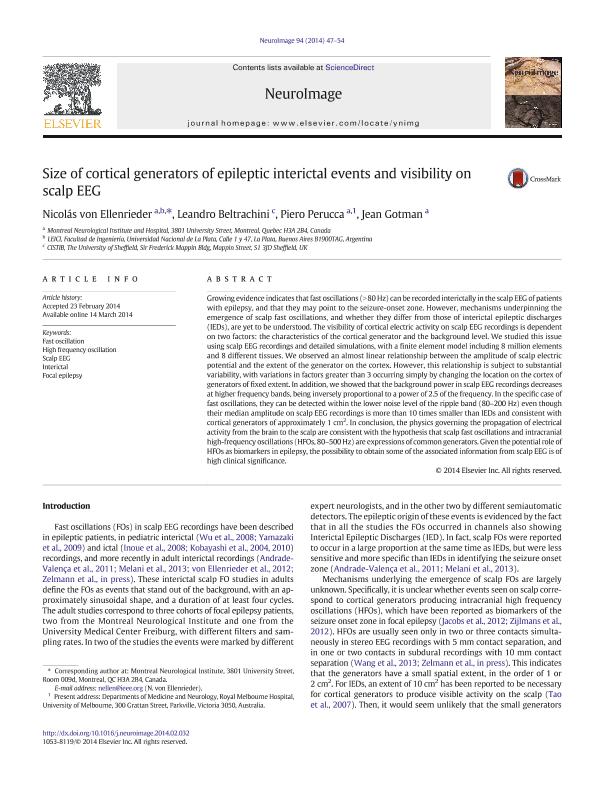Mostrar el registro sencillo del ítem
dc.contributor.author
Von Ellenrieder, Nicolás

dc.contributor.author
Beltrachini, Leandro

dc.contributor.author
Perucca, Piero
dc.contributor.author
Gotman, Jean
dc.date.available
2018-01-08T18:58:29Z
dc.date.issued
2014-07
dc.identifier.citation
Von Ellenrieder, Nicolás; Beltrachini, Leandro; Perucca, Piero; Gotman, Jean; Size of cortical generators of epileptic interictal events and visibility on scalp EEG; Academic Press Inc Elsevier Science; Neuroimage; 94; 7-2014; 47-54
dc.identifier.issn
1053-8119
dc.identifier.uri
http://hdl.handle.net/11336/32556
dc.description.abstract
Growing evidence indicates that fast oscillations (> 80 Hz) can be recorded interictally in the scalp EEG of patients with epilepsy, and that they may point to the seizure-onset zone. However, mechanisms underpinning the emergence of scalp fast oscillations, and whether they differ from those of interictal epileptic discharges (IEDs), are yet to be understood. The visibility of cortical electric activity on scalp EEG recordings is dependent on two factors: the characteristics of the cortical generator and the background level. We studied this issue using scalp EEG recordings and detailed simulations, with a finite element model including 8 million elements and 8 different tissues. We observed an almost linear relationship between the amplitude of scalp electric potential and the extent of the generator on the cortex. However, this relationship is subject to substantial variability, with variations in factors greater than 3 occurring simply by changing the location on the cortex of generators of fixed extent. In addition, we showed that the background power in scalp EEG recordings decreases at higher frequency bands, being inversely proportional to a power of 2.5 of the frequency. In the specific case of fast oscillations, they can be detected within the lower noise level of the ripple band (80–200 Hz) even though their median amplitude on scalp EEG recordings is more than 10 times smaller than IEDs and consistent with cortical generators of approximately 1 cm2. In conclusion, the physics governing the propagation of electrical activity from the brain to the scalp are consistent with the hypothesis that scalp fast oscillations and intracranial high-frequency oscillations (HFOs, 80–500 Hz) are expressions of common generators. Given the potential role of HFOs as biomarkers in epilepsy, the possibility to obtain some of the associated information from scalp EEG is of high clinical significance.
dc.format
application/pdf
dc.language.iso
eng
dc.publisher
Academic Press Inc Elsevier Science

dc.rights
info:eu-repo/semantics/openAccess
dc.rights.uri
https://creativecommons.org/licenses/by-nc-nd/2.5/ar/
dc.subject
Fast Oscillation
dc.subject
High Frequency Oscillation
dc.subject
Scalp Eeg
dc.subject
Interictal
dc.subject
Focal Epilepsy
dc.subject.classification
Ingeniería de Sistemas y Comunicaciones

dc.subject.classification
Ingeniería Eléctrica, Ingeniería Electrónica e Ingeniería de la Información

dc.subject.classification
INGENIERÍAS Y TECNOLOGÍAS

dc.title
Size of cortical generators of epileptic interictal events and visibility on scalp EEG
dc.type
info:eu-repo/semantics/article
dc.type
info:ar-repo/semantics/artículo
dc.type
info:eu-repo/semantics/publishedVersion
dc.date.updated
2018-01-08T18:41:38Z
dc.journal.volume
94
dc.journal.pagination
47-54
dc.journal.pais
Estados Unidos

dc.journal.ciudad
Amsterdam
dc.description.fil
Fil: Von Ellenrieder, Nicolás. McGill University. Montreal Neurological Institute and Hospital; Canadá. Universidad Nacional de la Plata. Facultad de Ingeniería. Departamento de Electrotecnia. Laboratorio de Electrónica Industrial, Control e Instrumentación; Argentina
dc.description.fil
Fil: Beltrachini, Leandro. University of Sheffield; Reino Unido
dc.description.fil
Fil: Perucca, Piero. McGill University. Montreal Neurological Institute and Hospital; Canadá
dc.description.fil
Fil: Gotman, Jean. McGill University. Montreal Neurological Institute and Hospital; Canadá
dc.journal.title
Neuroimage

dc.relation.alternativeid
info:eu-repo/semantics/altIdentifier/doi/http://dx.doi.org/10.1016/j.neuroimage.2014.02.032
dc.relation.alternativeid
info:eu-repo/semantics/altIdentifier/url/http://www.sciencedirect.com/science/article/pii/S1053811914001475
Archivos asociados
